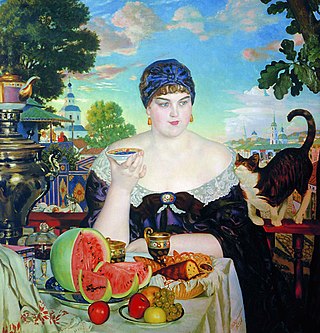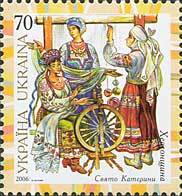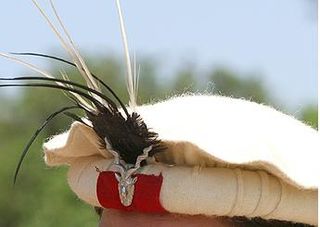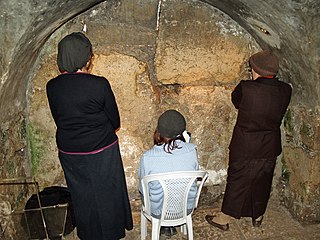
A wife is a woman in a marital relationship. A woman who has separated from her partner continues to be a wife until their marriage is legally dissolved with a divorce judgment. On the death of her partner, a wife is referred to as a widow. The rights and obligations of a wife to her partner and her status in the community and law vary between cultures and have varied over time.

A hat is a head covering which is worn for various reasons, including protection against weather conditions, ceremonial reasons such as university graduation, religious reasons, safety, or as a fashion accessory. Hats which incorporate mechanical features, such as visors, spikes, flaps, braces or beer holders shade into the broader category of headgear.

Bonnet has been used as the name for a wide variety of headgear for both sexes—more often female—from the Middle Ages to the present. As with "hat" and "cap", it is impossible to generalize as to the styles for which the word has been used, but there is for both sexes a tendency to use the word for pop styles in soft material and lacking a brim, or at least one all the way round, rather than just at the front. Yet the term has also been used, for example, for steel helmets. This was from Scotland, where the term has long been especially popular.
A parasite single is a single person who lives with their parents beyond their late 20s or early 30s to enjoy a more carefree and comfortable life. In Japanese culture, the term is especially used when negatively describing young unmarried women.
Mrs. or Mrs is a commonly used English honorific for women, usually for those who are married and who do not instead use another title, such as Doctor, Professor, President, Dame, etc. In most Commonwealth countries, a full stop (period) is usually not used with the title. In the United States and Canada a period is usually used.

Spinster is a term referring to an unmarried woman who is older than what is perceived as the prime age range during which women usually marry. It can also indicate that a woman is considered unlikely to ever marry. The term originally denoted a woman whose occupation was to spin. A synonymous term is old maid. The closest equivalent term for males is "bachelor" or "confirmed bachelor", but this generally does not carry the same connotations in reference to age and perceived desirability in marriage.
Bachelorette (/ˌbætʃələˈrɛt/) is a term used in American English for a single, unmarried woman. The term is derived from the word bachelor, and is often used by journalists, editors of popular magazines, and some individuals. "Bachelorette" was famously the term used to refer to female contestants on the old The Dating Game TV show and, more recently, The Bachelorette.

In the English language, an honorific is a form of address conveying esteem, courtesy or respect. These can be titles prefixing a person's name, e.g.: Mr, Mrs, Miss, Ms, Sir, Dame, Dr, Cllr, Lady, or Lord, or other titles or positions that can appear as a form of address without the person's name, as in Mr President, General, Captain, Father, Doctor, or Earl.
In legal definitions for interpersonal status, a single person refers to a person who is not in committed relationships, or is not part of a civil union. In common usage, the term 'single' is often used to refer to someone who is not involved in either any type of sexual relationship, romantic relationship, including long-term dating, engagement, marriage, or someone who is 'single by choice'. Single people may participate in dating and other activities to find a long-term partner or spouse.

Saint Catherine's Day, also called the Feast of Saint Catherine, is 25 November. It has retained its popularity throughout the centuries. It commemorates the martyrdom of Saint Catherine of Alexandria, one of the Fourteen Holy Helpers.

The pakol or pakul is a soft, flat, rolled-up, round-topped men's cap, usually worn in Afghanistan and Pakistan. It is typically made of wool and found in a variety of earthy colours, such as brown, black, grey, ivory, or dyed red using walnut. The pakol is believed to have originated in Chitral, or Gilgit-Baltistan in Pakistan.
A salutation is a greeting used in a letter or other communication. Salutations can be formal or informal. The most common form of salutation in an English letter includes the recipient's given name or title. For each style of salutation there is an accompanying style of complimentary close, known as valediction. Examples of non-written salutations are bowing, waving, or even addressing somebody by their name. A salutation can be interpreted as a form of a signal in which the receiver of the salutation is being acknowledged, respected or thanked. Another simple but very common example of a salutation is a military salute. By saluting another rank, that person is signalling or showing his or her acknowledgement of the importance or significance of that person and his or her rank. Some greetings are considered vulgar, others "rude" and others "polite".

A mistress is a woman who is in a relatively long-term sexual and romantic relationship with someone who is married to a different person.

According to halacha, married Jewish women are expected to cover their hair when in the presence of men other than their husband or close family members. Such covering is common practice nowadays among Orthodox Jewish women.
St. Catherine's Taffy is a variety of taffy made by French-Canadian families to celebrate the feast day of Saint Catherine of Alexandria, which takes place annually on November 25.
Religious clothing is clothing which is worn in accordance with religious practice, tradition or significance to a faith group. It includes clerical clothing such as cassocks, and religious habit, robes, and other vestments. Accessories include hats, wedding rings, crucifixes, etc.

Headgear, headwear, or headdress is any element of clothing which is worn on one's head, including hats, helmets, turbans and many other types. Headgear is worn for many purposes, including protection against the elements, decoration, or for religious or cultural reasons, including social conventions.
Sheng nu is a term popularized by the All-China Women's Federation that classifies women who remain unmarried in their late twenties and beyond. Most prominently used in China, the term has also been used colloquially to refer to women in India, North America, Europe, and other parts of Asia. The term compares unmarried women to leftover food and has gone on to become widely used in the mainstream media and has been the subject of several television series, magazine and newspaper articles, and book publications, focusing on the negative connotations and positive reclamation of the term. While initially backed and disseminated by pro-government media in 2007, the term eventually came under criticism from government-published newspapers two years later. Xu Xiaomin of The China Daily described the sheng nus as "a social force to be reckoned with" and others have argued the term should be taken as a positive to mean "successful women". The slang term, 3S or 3S Women, meaning "single, seventies (1970s), and stuck" has also been used in place of sheng nu.
Bachelor's Day, sometimes known as Ladies' Privilege, is an Irish tradition by which women are allowed to propose to men on Leap Day, 29 February, based on a legend of Saint Bridget and Saint Patrick. It once had legal basis in Scotland and England.

A single woman in the Middle Ages was a woman born between the 5th and 15th century who did not marry. This category of single women does not include widows or divorcees, which are terms used to describe women who were married at one point in their lives. During the Middle Ages in Europe, lifelong spinsters came from a variety of socioeconomic backgrounds, though elite women were less likely to be single than peasants or townswomen.











